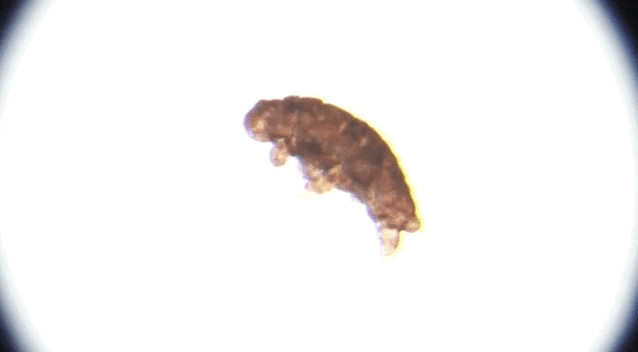Submissions for the [FIGURE 1.A.] 2025 EXHIBITION are closed
Stay tuned for more information about the selected artworks, exhibition dates, and upcoming events.

Theme of the Year
Extreme Environments: BEYOND LIMITS
Extremophiles are organisms capable of surviving and thriving in unimaginable conditions, such as extreme heat, cold or radiation. They can be uni- or multicellular, ranging from bacteria to plants, fish or invertebrates. They challenge our perceptions of life’s boundaries and serve as models for studying adaptation in a changing climate. As Earth’s temperatures rise, will we, humans, need to adapt similarly? How can we achieve this adaptation?
Video from waterbearmosspiglet.wordpress.com
Photo from Maxence Pira in Unsplash
The EXTREME ENVIRONMENTS exhibition seeks to address these questions by exploring other organisms’ “success stories”. What factors determine their resilience? What might a human look like in the year 2500? Moreover, which physical, psychological and technological limits do we face and how do we push past what is typically considered possible?
Will extreme heat change us? How might human biology evolve or adapt in response to this new reality? How will increasingly unpredictable weather events reshape our cities, ecosystems, and way of life? With rising sea levels threatening coastal areas and biodiversity under pressure, can our innovations and scientific advancements help protect the delicate balance of our planet?
Given the ongoing race for space travel, will we be able to inhabit another planetary body? If Earth's environments become too harsh, will Mars, the Moon, or beyond offer a refuge? And how will we address the ethical, biological, and technological challenges of colonising new worlds? Alternatively, will we focus on adapting Earth to better support life amidst changing conditions?
This exhibition encourages us to consider the profound impact of extreme environments — both on Earth and in space — on humanity’s future. From polar ice caps to Mars' arid landscapes, this journey is about exploring our capacity for survival, adaptation, and progress. What lies beyond our current understanding, and are we ready for the challenges ahead?
CATEGORIES
We welcome submissions that either respond to this year's theme, "Extreme Environments: Beyond Limits," or explore other subjects in the following categories:
CATEGORY 1: SCIENCE-INSPIRED ART
Artworks generated from experiments, data acquisition, or technical scientific material collected during research and scientific experimentation. This category welcomes all types of images and videos documenting science, such as photography, microscopy, computer-generated images, data visualization, etc.
Both scientists and artists who have conducted and documented scientific experiments are encouraged to participate.
CATEGORY 2: ART-DRIVEN BY SCIENCE
Artworks inspired by scientific topics or art projects incorporating scientific methodologies. This category welcomes all types of images, videos, drawings, paintings, sculptures, digital art, etc. The authors should provide specific descriptions of how their artistic work engages with a scientific topic.
This category is open to both scientists transforming their scientific images into purely artistic renditions and artists drawing inspiration from science or incorporating scientific methodology and technology into their work.
For more info, check out the Terms & Conditions.
The [Figure 1.A.] Scientific Art Exhibition is an annual scientific art competition and exhibition that invites scientists worldwide to participate with images of their scientific work. The competition is also open to artists working on scientific topics or utilizing scientific methodology in their process. The best pieces are selected with the help of our jury. The [Figure 1.A.] team exhibits the selected works in Lausanne, Switzerland.
Our main goal is to engage the public in exploring science through the artistic merit of the images and to appreciate them individually for their aesthetic value as pieces of art.
FREQUENTLY ASKED QUESTIONS
Is this a photography/microscopy-only exhibition?
No, we welcome all types of images, not only photography or microscopy. Send us your computer-generated images, data visualization, even drawings or painting renditions of your favorite scientific images. Get as creative as you like.
Can I submit a not strictly scientific image?
Yes. The only thing you need to do is to clearly indicate if the piece is coming from experiments/data or if the image is an artistic rendition. We accept various artistic representations, including but not limited to painting, digital art, sketches, visual art, sculpture, video, etc.
Do I have to be a scientist affiliated with a university to submit an image?
No. Scientists from universities, institutes, and companies are welcome to make a submission. In addition, artists whose work is inspired by technology and the scientific process or incorporates science methodologies can also submit.
How do I submit an image?
You can submit your artwork by using the submission form above.
Can I submit more than one image?
Yes, you can submit up to three images.
What are the requirements for image submissions?
Max. Size 100 MB, Minimum resolution: 300 dpi. The maximum resolution possible is strongly recommended. The files should be named: [Category_name]_[Title_of_the_work]. When filling out the submission form, don’t forget to let us know about the technical specifications of the image (for the scientists) and a general description of what we see (for the general public).
Will images be offered for sale in 2025?
Images will not be offered for sale in the 2025 main [Figure 1.A.] exhibition. The [Figure 1.A.] association reserves the right to make postcard reproductions of the images for sale only during the duration of the exhibition. Proceeds from sales will be distributed to the [Figure 1.A.] association for event organization. Upon interest from the authors at the end of the exhibition, unsold postcards made from their images can be sent to them via post.
![[Figure 1A]](http://images.squarespace-cdn.com/content/v1/58e61af4a5790ab156e17bc1/04fe6ec5-55ff-401c-bf64-4d2b756ff838/Logo+transparente+background.png?format=1500w)

